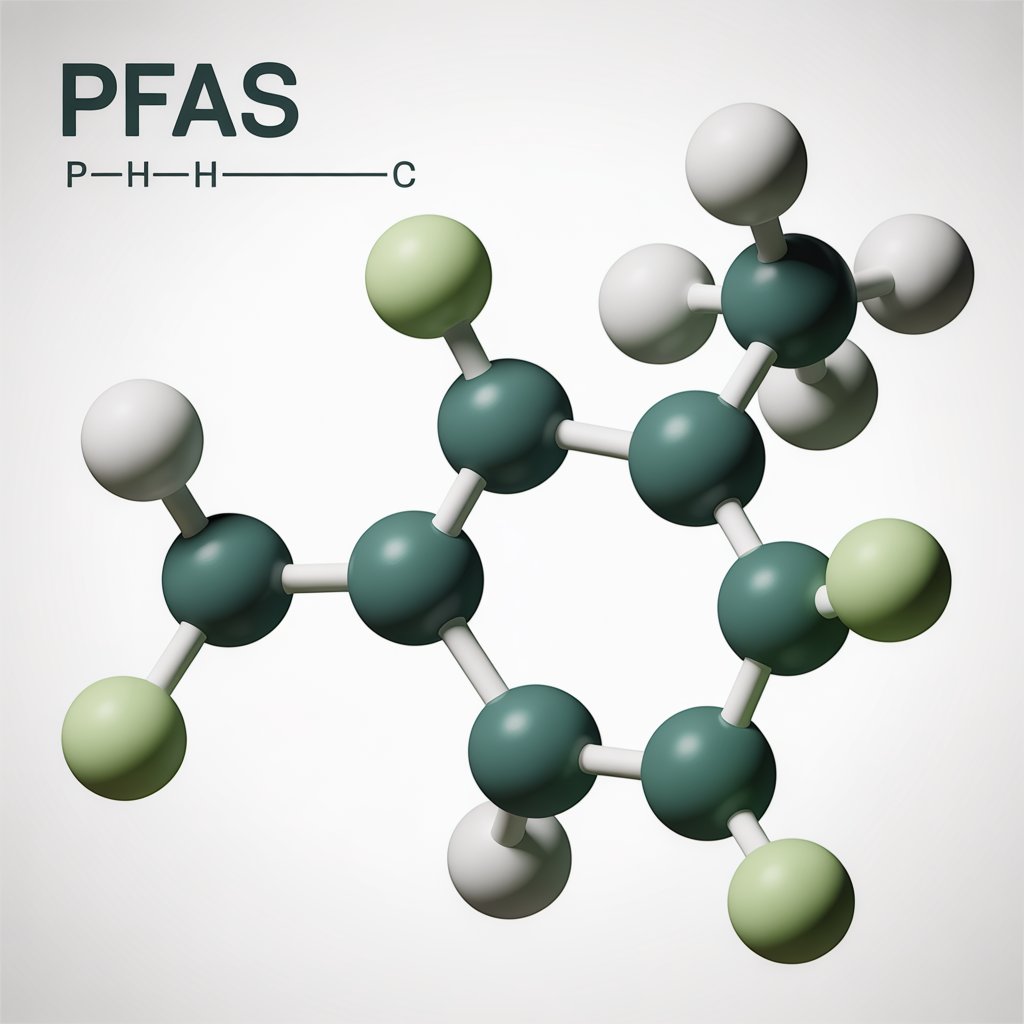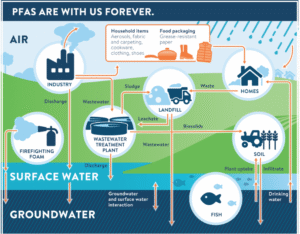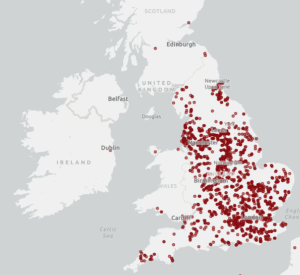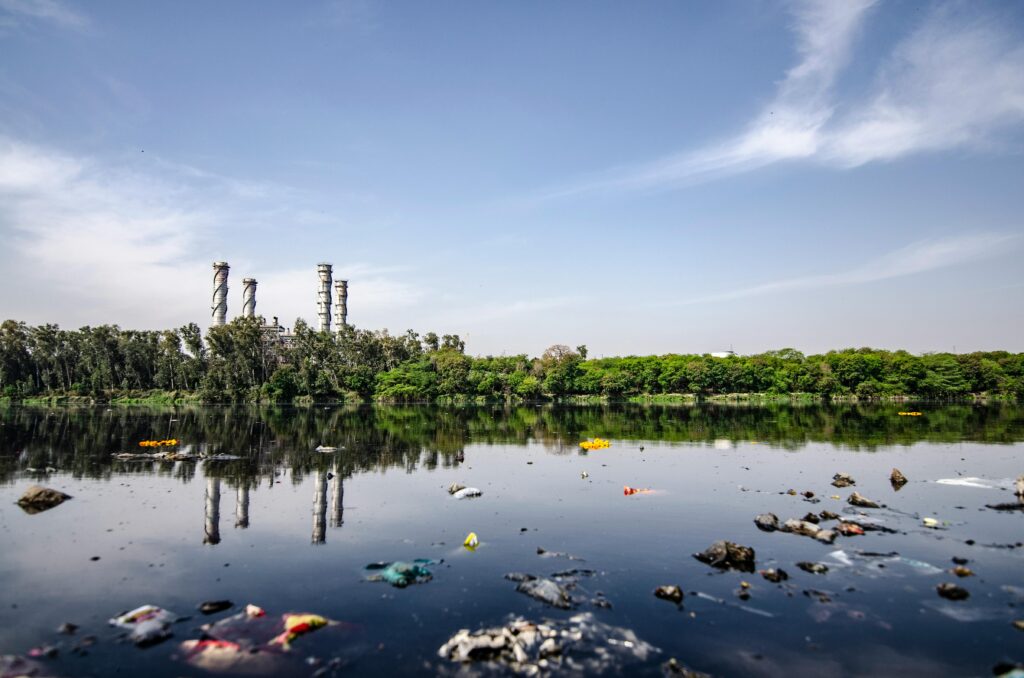
- Nick Water DR
- Published
- Updated November 10, 2025
- Articles, Guides & Maintenance, Reverse Osmosis, Water contaminants, Water Filtration
Forever Pollution: The Hidden Chemical Threat in Britain’s Water — and How to Protect Your Home
1. What Are PFAS? The Invisible, Indestructible Chemicals in Our Everyday Lives
PFAS — short for per- and polyfluoroalkyl substances are a vast class of synthetic compounds that share a defining feature: a chain of carbon atoms bonded tightly with fluorine. This carbon–fluorine bond is one of the strongest in chemistry, meaning PFAS don’t easily degrade under heat, light, or biological action. They were first developed in the 1940s by chemical giants like 3M and DuPont, who quickly discovered that these compounds repelled water, oil, and dirt like nothing else.
From the start, PFAS seemed like miracle molecules. They were used to make non-stick cookware, waterproof outdoor clothing, stain-resistant carpets, greaseproof food packaging, and firefighting foams. In technical industries, they’re found in semiconductor manufacturing, aviation hydraulics, and medical equipment. They are slippery, stable, and nearly impossible to destroy.
Physically, PFAS molecules are tiny — around 0.001–0.002 microns thousands of times smaller than a bacterium or even most viruses. Once they enter water, they dissolve at a molecular level and can travel great distances underground or through river systems. Their size makes them extremely difficult to capture or remove with standard filtration technologies.

Unfortunately, the same properties that made PFAS so commercially valuable also make them forever pollutants. They persist in soil, sediment, and living tissue for decades. Many PFAS compounds can accumulate in blood and organs, slowly building up over time. Studies have now detected PFAS in the blood of 99% of people tested globally, including in remote regions with no direct industrial sources.
2. How PFAS Took Over: From Non-Stick Pans to Luxury Fabrics and Firefighting Foams
There are now more than 12,000 known PFAS compounds registered by the OECD Athough fewer than 50 are routinely monitored. They are grouped broadly into two types: long-chain and short-chain PFAS. The DWI in the UK has pro active alert surrounding PFAS that is currently ” guidance ” in the form of monitoring 47 of the best known that will in due course become more specific regulation but as usual this is likely slow to evolve …
Long-Chain PFAS These were the original “workhorses” of the chemical family:
PFOA (Perfluorooctanoic acid) — used in Teflon, non-stick coatings, cable insulation, and industrial sealants.
PFOS (Perfluorooctane sulfonate) — the key ingredient in firefighting foams, waterproof textiles, and metal plating baths.
PFNA, PFHxS, PFDA — used in automotive parts, surfactants, and lubricants.
They are now known to be bioaccumulative, persisting for years inside the body. Because of that, PFOA and PFOS were banned or heavily restricted in most developed countries by the late 2010s. However, their residues remain widespread.

Short-Chain PFAS
As regulations tightened, manufacturers switched to shorter carbon-chain compounds like PFBS, PFHxA, and PFBA. These are more mobile in water and break down faster in the body — but also spread more easily through soil and aquifers.
They are now used many circumstances , water-repellents , outdoor gear and luxury fabrics , grease-resistant coatings in takeaway packaging, cleaning agents for semiconductors and precision optics. This is a very long list !
Global Footprint
In the United States, PFAS production and discharge were once dominated by DuPont and 3M. Both companies have since faced multibillion-dollar settlements — including a $10.3 billion agreement (2023) with US states to fund water cleanup.
In Europe, PFAS were produced and used at smaller scales but are still found in military sites, paper mills, and textile regions. The EU Chemicals Agency (ECHA) is now moving toward an almost complete ban by the early 2030s.
3. Mapping the UK’s Hidden PFAS Footprint: Are Our Tests Keeping Up?
Although the UK stopped manufacturing most long-chain PFAS decades ago, the country still carries a widespread legacy of contamination.
In 2023, the Guardian and Watershed Investigations revealed that PFAS had been detected in raw water sources serving around 50% of England’s population. The highest concentrations were found near industrial sites, airports, and former RAF bases, where firefighting foams had been used repeatedly.
There are huge research gaps in our understanding of PFAS contamination across the UK … It is beyond alarming to see the high correlation with excess cancer rates in. specific examples where levels are high such as here in Bentham . The financial scale of the burden to clean up the 10000 sites identified as at rick is conservatively put in the 100s of millions over the next 20 years before even introducing the human cost .
Sites where PFAS have been identified at 10ng/l or over

RAF Fairford (Gloucestershire) and MoD Woodbridge (Suffolk) have recorded PFOS levels in soil and groundwater exceeding 10,000 ng/L.
The Drinking Water Inspectorate (DWI) now recommends a limit of 100 ng/L for total PFAS and 10 ng/L for any individual compound, but these are advisory rather than legally binding. In comparison, the US EPA has proposed enforceable limits as low as 4 ng/L for PFOA and PFOS — roughly 25 times stricter.
Testing Challenges
PFAS analysis requires sophisticated laboratory instruments — typically liquid chromatography–tandem mass spectrometry (LC-MS/MS) — capable of detecting parts per trillion. A single test for 40 PFAS compounds can cost hundreds of pounds, making routine screening prohibitively expensive for smaller water networks or private boreholes.
As a result, many parts of the UK are still untested or infrequently tested, especially rural areas or private wells. Without consistent national data, it’s difficult to map risk or enforce remediation.
4. The Health Reality: What Science Says About PFAS Exposure and Risk
Research over the past 30 years has transformed PFAS from obscure industrial additives into one of the world’s most scrutinised public health concerns.
Dozens of peer-reviewed studies — from Harvard, the University of Exeter, and the US National Institutes of Health — have linked specific PFAS exposure to measurable biological effects.
Documented Health Associations are alarming and growing ! This table outlines a glossary of health outcomes

Cancers , nervous , reproductive and respiratory issues , metabolic and immune function, developmental problems … the list of negative health outcomes is uncomfortably long ..
PFOA is now classified by the International Agency for Research on Cancer (IARC) as “carcinogenic to humans” (Group 1) — with evidence for kidney and testicular cancer. PFOS is listed as “possibly carcinogenic” (Group 2B)
Even short-chain PFAS, once thought safer, are now under review for cumulative toxicity and mobility in groundwater. Because exposure comes from multiple routes — water, food, dust, and consumer products — total human burden can add up quickly.
Given all the above concern about environmental PFAS pollution is increasing .The Royal Society of Chemistry is calling for the UK to overhaul its drinking water standards to address challenges as more than a third of drinking water sources in the UK show MEDIUM or even HIGH risk levels of PFOS or PFOA !.
5. Protecting Your Home: The Best Ways to Remove PFAS from Water and Soil
There is a huge problem that has already been released into the environment from historical proaction of long chain PFAS . Even in this ‘legacy’ scenario, where emissions cease immediately and only legacy PFAS – long-chain PFAS that received the first regulatory attention for restriction and phase out (such as PFOS and PFOA) – are remediated, then the cost is estimated to be about €95 billion over 20 years.
In the ‘emerging’ scenario, where emissions continue and remediation efforts include short-chain and ultra-short chain PFAS, like TFA, which are difficult to deal with, then costs rise to around €2 trillion over the next 20 years. A phase out of these difficult to remediate, emerging PFAS would be needed to lower this 20-year estimate, otherwise remediation could cost over 100 billion euros per year in perpetuity.
While governments debate long-term regulation, homeowners do have practical options to safeguard their families today . Precautionary measures for securing your drinking water from PFAS and understanding what are the best methods to do this are paramount .
There are currently 3 methods commonly touted as able to remove PFAS
1. Reverse Osmosis (RO) — The Gold Standard
A 2021 Environmental Science & Technology review found RO achieved up to 99.8% PFAS reduction in controlled trials.

2. Granular Activated Carbon (GAC) — Often included in the reverse osmosis machines as well . These are reliable for removing long-Chain PFAS
They adsorb organic molecules onto porous carbon . US EPA field studies show 80 % reduction of long-chain PFAS but only 40–60% for shorter types but importantly cartridges must be replaced regularly; once saturated, the carbon must be reactivated or incinerated safely.
3. Ion-Exchange Resins (IX/AER) — Targeted and Regenerable
These resins swap ions in water for benign ones, selectively capturing PFAS molecules. Comparable to or better than GAC for short-chain PFAS. Also generates PFAS-rich brine during regeneration, requiring careful waste handling.
The Bigger Picture
The UK government + DWI along with its global contemporaries is now reviewing PFAS policy in light of international findings to expand monitoring and tighten regulation . The problem comes at an already fragile time for the water companies in the UK who are creaking with aging infrastructure and increasingly falling behind on existing sewage pollution targets .
In 2024, the Environment Agency confirmed that sewage sludge used on farmland can contain measurable PFAS residues where biosolids have contaminated agricultural soil . Spreading sewage sludge on farmland ties together two pollution pathways — wastewater and agriculture . While marketed as an eco-friendly fertilizer, this sludge contains PFAS, hormone disruptors, microplastics, and banned chemicals that can leach into soil, water, and food crops.
Until stricter limits and cleanup programmes are in place ,don’t expect a quick fix here .. Personal filtration remains the most effective line of defence — particularly for families with young children, private boreholes, or properties near historic industrial or military sites.
Conclusion
PFAS are the price of convenience — miracle molecules that outlast us from Teflon pans to waterproof parkas, they’ve made modern life cleaner, safer, and more efficient — yet left a chemical fingerprint in our blood, soil, and water that poses serious risks to our health and wellbeing .
In the UK, awareness is rising, but regulation will always lag behind the science especially given the egregious costs of clean up and who will have to find the money to carry it out . The most pragmatic protection, for now, lies with informed homeowners: investing in high-performance water filtration, avoiding PFAS-treated consumer goods where possible, and demanding greater transparency from utilities and regulators.
Because the truth is simple: what we can’t see can still stay with us — forever.
Set up a free consultation to help understand your specific risks and itemise some options to address concerns ..
https://thewaterdr.com/contact/

About the Author
Nick Smith | Founder | The Water Dr. & Cellthyhomes
Nick has dedicated years to studying building biology, healthy living environments, and the impact of environmental toxins on inflammation.
Whilst regulations for UK drinking water are slow to adapt, & influenced by conflicts of interest, Nick conduct comprehensive research on global regulations & scientific literature to offer water filtration solutions that provide clean drinking water free from all harmful contaminants.





